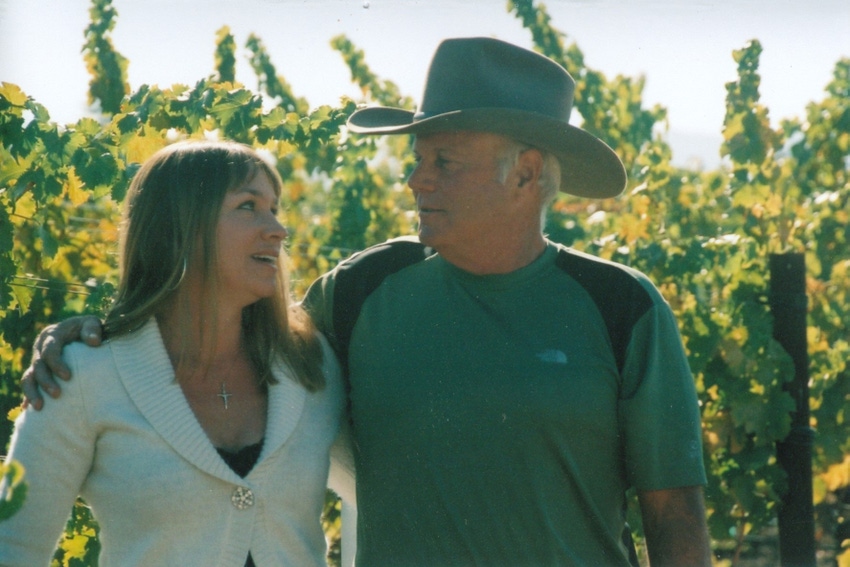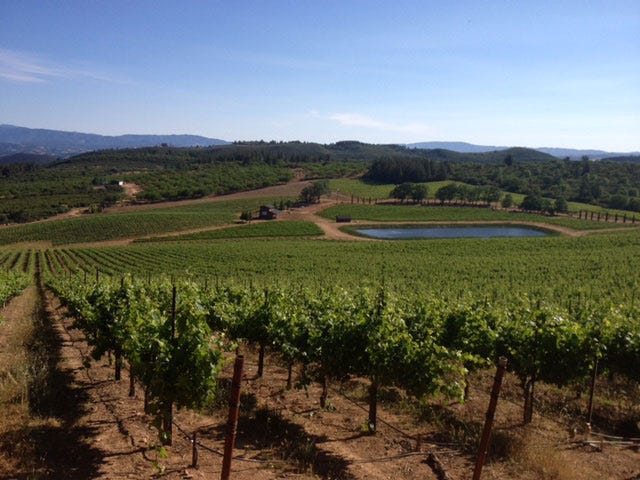
With a few of his Chardonnay vines beginning to flower in the third week of May, Lake County grower Ron Bartolucci was expecting the 2017 bloom to have started in all of his red and white wine grape varieties by the end of May.
Although about a week later than the several previous years, when drought hastened vine development, the timing of this year’s bloom is about normal for his vines, he said.
The few frost events that affected some of his blocks after budbreak caused no damage. However, he remained prepared to activate his overheard sprinklers to control any frost, if necessary. During his 40-plus years of growing grapes in Lake County, Bartolucci has experienced frost events on rare occasions as late as the first week of June at his two lower elevation ranches.
For the past 15 years, the Bartolucci Vineyards operation, based in Finley, Calif. has included his daughter, Deanna, the chief financial officer.
They grow grapes at four ranches. Two are in the Big Valley appellation, along the shores of Clear Lake between Kelseyville and Lakeport where the elevation ranges from 1,330 to 1,440 feet above sea level. There, the Bartoluccis take advantage of the fairly deep soils, good soil nutrient levels and good water-holding capacity to grow Chardonnay, Muscat Blanc, Sauvignon Blanc and Merlot varieties.
The other two ranches are in the Red Hills appellation, which borders Clear Lake southeast of Kelseyville. One ranch ranges in elevation from 1,680 to 1,880 feet above sea level, the other from 2,160 to 2,360 feet.
“The red volcanic soils here are totally different than in the valley,” Ron says. “These rocky sites, which are more limited in nutrients and water-holding capacity, allow us to grow Bordeaux varieties with smaller, thick, dark-skinned berries. These grapes produce wines that are rich, full-bodied, complex and elegant.”
The varieties here include Malbec, Petite Syrah, Petit Verdot and eight different clonal selections of Cabernet Sauvignon.
Overall, the quality of the crop last year was very good and all varieties hit the targeted yields with one exception.
“The Cabernet Sauvignon was a little off in weight,” Ron says. “Just as it was ready to harvest, we had a heat spell along with wind, but the wineries were backed up for space,” he says. “We usually pick this variety at 27 ºBrix. However, by the time we could harvest these grapes, they were up over 29 ºBrix. So, we lost tonnage.”
One of their production challenges could be managing the vigorously-growing vines to achieve the desired quality and yield goals for the individual varieties and particular site conditions. This reflects a big improvement in soil moisture levels compared to the drought of the previous several seasons.
“We’ve had substantially more rainfall this year than last year,” Ron says.

One of Bartolucci Vineyards ranches in Lake County’s Red Hills AVA.
For example, since last fall, some areas of the Big Valley have received a total of about 40-plus inches of rain, he notes. That’s a third or more greater than for the same period last year.
Meanwhile, precipitation in some areas of the Red Hills has totaled from 53 to 60 inches since last July. That compares to around 30 inches a year earlier.
The Bartolucci family has been growing grapes in California since 1921. That’s when his Italian-born grandfather, Andrea, planted a vineyard near Oakville in the Napa Valley. Growing up, Ron learned about growing grapes, working alongside his father and hired hands tending vines and working before heading to college and earning his MBA.
At the age of 27, Ron decided to leave a comfortable position with a San Francisco financial firm for the uncertainties of becoming a wine grower in his own right.
He and his father, Henry, spent six months analyzing soils, microclimates, water availability and other factors in various areas of the state before selecting Lake County, where he planted his first vines in 1973.
“The diversity of plants and soils, good water supplies and favorable temperatures makes this area unique and contributes to a sustainable, balanced approach to farming that’s ideal for growing grapes,” Ron says.
“This is a special area, and I think we as a grower community are proving that as the reputation for superior quality of the fruit and wines produced here continues to expand.”
The Bartoluccis are focused on preserving and sustaining the quality of their land for the sake of generations to come. “We strive to make each of our vineyards an extension of its natural surroundings,” he says.
All the land is farmed using sustainable practices, including some blocks that are certified to meet national and international organic standards.
Bartolucci Vineyards began farming organically in the late 1980s, and the first vineyard was certified organic in 1993. Since then, they have worked diligently to incorporate what they have learned about organic principles and practices in a sustainable farming method.
The Bartoluccis pay close attention to keeping the soil nutrients as balanced as possible. “It’s too expensive trying to change all the nutrients at once,” Ron said. “We learned that you first have to correct the level of the most-limiting factor. Once you do that, often other nutrients and biological activity in the soil become more closely synchronized. It can take years before you finally get everything in proper balance.”
Understanding and achieving the right ratio of beneficial insects and the pest insects they prey on is another critical component of the Bartoluccis’ sustainable practices. That, in turn, includes the use of cover crops that provide habitat for the beneficials and produce organic matter.
Depending on species, cover crops can be used to add or extract nitrogen, carbon, potassium or other nutrients required to provide balance in the soil, Ron said. “Cover crops also improve soil health by increasing activity of microbes, bacteria, fungi and other organisms.”
Last year, for the first time, he added leaf temperature sensors to his use of neutron probes, Et readings and other measures of soil and crop moisture conditions. “We’re very sensitive about the amount of water we use,” Ron explains. “We give the vines what they need to achieve our production and quality goals, but no more.”
His approach to growing grapes stems from the Bartolucci work ethic and his experience learning the business from the ground up.
“In our family, we’re taught that if we want to get the best results from our workers, we have to show we know how to do their work by getting our hands dirty and working as hard as they do to set the example,” Ron says.
He can still tackle just about every vineyard task from planting vines, pruning canes and thinning shoots to driving a tractor, Ron says. “However, even though I know how to pick grapes, I’ve never had to do that job at the pace our workers do,” he admits.
As demanding, both physically and mentally, owning and operating a wine grape vineyard can be at times, Ron can’t imagine a more fulfilling way of living his life.
“I love growing things,” he says. “I love developing vineyards. I love our very dynamic industry, which is constantly evolving and moving forward. If operating a vineyard was monotonous, I wouldn’t be doing it. There’s so much more for me to learn and to experiment with to improve our practices. It’s not work for me. It’s intriguing.
“I’m very blessed to be in a position where I can do something I truly love and, when the day comes, pass it down to my daughter and then on to generations to come. That’s really special.”
About the Author(s)
You May Also Like




